Difference between revisions of "Diax"
Hanskerensky (talk | contribs) m (→Links: Repaired Link URL) |
|||
| Line 113: | Line 113: | ||
In English and German: | In English and German: | ||
* [http://diax.fotohistoricum.de/ Diax website] by Peter Geisler (the man who wrote ''the book'' about Diax) | * [http://diax.fotohistoricum.de/ Diax website] by Peter Geisler (the man who wrote ''the book'' about Diax) | ||
| + | * [https://cameracollector.net/voss-diax/ More about Voss Diax models] in [https://cameracollector.net/ cameracollector.net] | ||
* [http://www.photo-manuals.com/manual/walter-voss/film-compact-camera Diax Ib and IIb Camera Manual : Photo-Manuals.com] | * [http://www.photo-manuals.com/manual/walter-voss/film-compact-camera Diax Ib and IIb Camera Manual : Photo-Manuals.com] | ||
* [https://www.butkus.org/chinon/diax/diax_ib_iib/diax_ib_iib.htm Diax Ib and IIb PDF manual] at [https://www.butkus.org/chinon/index.html OrphanCameras.com] | * [https://www.butkus.org/chinon/diax/diax_ib_iib/diax_ib_iib.htm Diax Ib and IIb PDF manual] at [https://www.butkus.org/chinon/index.html OrphanCameras.com] | ||
Latest revision as of 19:48, 23 January 2024

|
| Diax (1950ies variant with bigger finder) with the camera maker's rangefinder "Photometer" attached. image by Tony Kemplen (Image rights) |
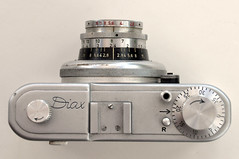
|
| 1950ies Diax from above image by Tony Kemplen (Image rights) |
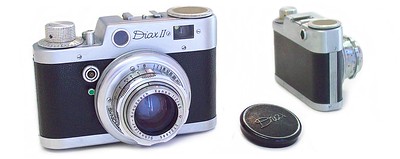
|
| Diax II image by OZBOX (Image rights) |

|
| 1940ies Diax: small viewfinder image by barney_51 (Image rights) |
The Diax cameras are a series of 35mm viewfinder and rangefinder cameras made from 1947 to 1957 by the company Walter Voss based in Ulm/Donau (Germany).
The most characteristic model is the Diax Ia for interchangeable lenses, with 3 different viewfinders in the top, each in a different color: blue for 35mm lenses, yellow for 85 or 90mm lenses and neutral for 45 or 50 mm lenses.
The Diax II, Diax IIa and models are rangefinder cameras, the Diax II a common one, the the Diax IIa with two viewfinders, one for use witn 50mm lens, the other for 85-90mm lenses.
The 'b' models are like the 'a' models, but with rapid film advance lever instead of a knob. The Diaxette is a far relative, the budget model of the Diax camera family.
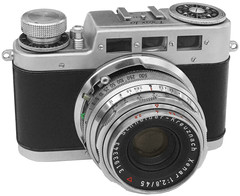
|
| The 3-finder version Diax Ia for interchangeable lenses image by Alf Sigaro (Image rights) |
 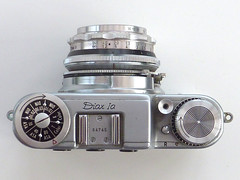
|
| Diax Ia camera back with 3 finder oculars, and top view. images by Tony Kemplen (Image rights) |
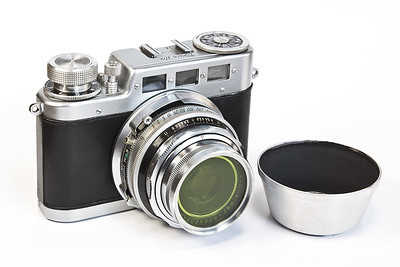
|
| Diax IIa with filter and lens hood image by gorkola (Image rights) |

|
| the Diax IIb with "only" two finders :-) image by Adrian Gee (Image rights) |

|
| Diax IIb, lens detached image by Casual Camera Collector (Image rights) |
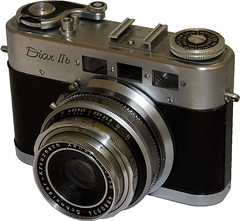
|
| Diax IIb image by John-Henry Collinson (Image rights) |
The Diax Ia was available with one of the following standard lenses, which varied widely in price: Westar 50mm f/3.5, Xenar 45mm f/2.8, or Xenon 50mm f/2.0, all set in a Synchro-Compur shutter. Additional lenses made for the camera included a Xenagon 35mm f/3.5, and a Tele-Xenar 90mm f/3.5.[1]
Notes
- ↑ Der Fotohelfer, Photo-Porst, c.1951, page 155 (German)
Links
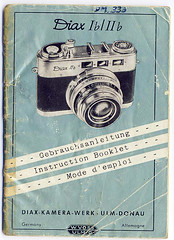
|
| Diax Ib IIb instruction manual scanned by John-Henry Collinson (Image rights) |
In English and German:
- Diax website by Peter Geisler (the man who wrote the book about Diax)
- More about Voss Diax models in cameracollector.net
- Diax Ib and IIb Camera Manual : Photo-Manuals.com
- Diax Ib and IIb PDF manual at OrphanCameras.com
- Diaxette PDF manual at OrphanCameras.com
- Diax booklet in PDF at OrphanCameras.com
In German:
In Danish:
- Diax pages at http://www.kamerasamling.dk by Leif Johansen
In French: